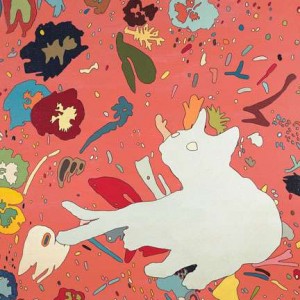Dan Baldwin interview
Dan Baldwin is one of the country’s most prominent contemporary artists. He uses motifs of skulls, birds, flies, flowers and guns in his work, but by intertwining these motifs with elements from politics and culture and presenting these opposing elements in pop candy colours Baldwin both attracts and uneases the viewer. Baldwin graduated from Maidstone School of Art and has since exhibited in London, Brighton, Newcastle, New York, Paris and Hong Kong.

Can you tell us where you are right now?
I’m in my home/office/studio in West Sussex –a cottage near Storrington.
What are you working on at the moment?
Many things: two book projects, charity events, a new print release, new paintings in gloss on birch ply-wood panels, conceptual works, pot commissions, conceptual pots..

Where do you draw your inspiration from?
An ever-developing movement forwards, I’m naturally competitive yet experimental I think – and there’s a constant need to push. I think there’s scope to go in many directions – with ceramics for example, you’re learning new things all the time, so it just never stops progressing.
Why did you choose art as your career path?
I was always creative as a boy. Aged 16 I enrolled on a plumbing evening course which I didn’t enjoy much. After school I was accepted as a plumbing apprentice on a YTS scheme. It was £28 a week unblocking toilets and doing church roofs, guttering and lead work – valuable experience but not for me. After a year of this I left and went back to my old school. My art teacher there guided me to Eastbourne Art College as art was the only thing I did well at. I subsequently discovered a new world. From 1990 until I went full time in 2006 I felt that if I could do this as a living that would be the ultimate dream.
Your art appears like a mix between street art, fairytales and graphic illustration – how do you combine these aesthetics?
It comes from all the different layers in one piece. I bring into a work layers from many sources. I trained in illustration for five years, not fine art, but I was more inspired by fine artists. When I was an illustration student they said I wasn’t an illustrator as I worked in mixed media. They couldn’t place my work into an ‘illustration’ category. I disagreed. I said ‘surely it’s just a different format? Why can’t a painting be a book cover?’
After I graduated I made a book cover and a CD cover. You make the rules. I am collector of objects, I love combining paint with an object and then hand painting, or silk-screening, like Warhol or Rauschenberg, but making something new. I studied art history and have seen what’s been before and it took 16 years to create my language but it is still evolving – that will never end.
What prompted you to move into ceramics?
Pure random attraction to objects. One day I just picked up a marker pen, started doodling on a Poundland pot, and had a moment of clarity. I’d filled up thousands of pages for years with a series called ‘Evil n Sick n Need Help’ and it was very separate to my paintings, just my mental drawings. So I started doing ‘Evil n Sick’ ceramics. The beautiful pot with a very dark fucked-up decoration really interested me. That led to hand-painting factory moulded biscuit pots, getting them glazed and fired, and learning to use ceramic paints. That developed to handmade pots and these became like my paintings.
 How have these developed?
How have these developed?
My goal was to get a ceramic like a Baldwin canvas. It’s a different technique that has developed from 3D clay casting of objects to working in precious metals, like pure gold, and the highly advanced ceramic works where we are now. It’s been about eight years since that first doodle pot and constantly learning new ways of doing things. It’s a satisfying medium, with never-ending possibilities.
What keeps you passionate about art?
A constant progression, a hunger to get to a higher level – that feeling you get from selling a piece and success. I’m highly critical of my work and I’m always trying to make it better. What I love is getting an email about a show in Abu Dhabi, or at the Royal Academy, a new silkscreen, or a book project in LA. You never know what is about to pop up – a commission, or a sale. Even when a student emails to say they are studying your work in GCSE, new ideas, new works – it’s addictive.
Do you think great art can ever be appreciated properly by the public at large?
Yes I think so. I think we are closer to being mass consumed by art than we ever have been. When I was a student people didn’t know about Warhol or popular art. Now you get young kids into art. I have a lot of younger fans, that’s the result of Banksy, or Tate Modern, Hirst and Hewlett. I was stood outside there once listening to these kids saying how much they loved it all. People go to art shows a lot more now. I don’t know about appreciated, I mean look at the outrage with Hirst’s naked woman, but it creates a debate. Art is seen a lot more, that elitist thing has been broken down a bit – Gormley’s figures on the beach, Kapoor’s Olympic sculpture, or the turbine hall. Grayson Perry will appear on chat shows as does Tracey Emin. Art is in our consciousness a lot more as a society than it was when I was a boy.
Do you think it is important for art to make political statements?
Not always, but like music, it’s musicians and artists that speak out –if you’re passionate and you are affected by things in the world you can’t help it. We live in a society of controlled media, no free speech, don’t be anti-patriotic – it’s a scary time. You can’t say anything anti-religious. Artists have always used satire against the establishment, but it’s difficult – we also want success. Leonardo da Vinci would paint subliminal messages into his works which were commissioned by the church. Artists have the power and freedom in a way to say things others can’t, for example the t-shirts of Katherine Hamnett or a campaigner like Vivienne Westwood. Art, fashion and music filter down to the street. As artists we are affected by the world and it comes out in our work naturally but it’s to what extent we want to bring that in. Sometimes its easier to be ignorant, it’s hard to make a change, the world is corrupt – we all know that –but artists can help to spread a message and do have a wide audience.
 Do you feel you have to distance yourself from any tags you have or are you comfortable with them?
Do you feel you have to distance yourself from any tags you have or are you comfortable with them?
I’m not sure I have a tag. The one tag I’ve been linked with is the urban one, and it’s not my background. I’m grateful to the exposure, very, but I’m not urban. I never saw it as being so. Would you call Rauschenberg urban? Or Basquiat? I’m consciously moving away from that with my work and with the people I work with – I don’t know where I fit. I feel like an outsider, maybe that’s from living in West Sussex or maybe all artists feel like that.
How connected do you feel to the value of your work? Is it something you keep a track of?
We are in a strange time currently. My prices built up over many years, from when I started to sell in 2003, upwards – in 2007 a lot of works were sold, every single work I made and people have tried to resell those – flip them for profit. I just try and focus on work and moving forwards. I keep track of all aspects of my output though, and have worked hard to survive and grow. I was advised to consider everything, every work, and I valued that advice. So in 2008 I had just one show, the same in 2009 – same in 2010 –the same with print – I keep it tight.
Do you think popular culture feeds into art or does it work the other way round?
Art definitely feeds down into popular culture, with album covers and stage sets, like Rihanna at the Brit awards (Damien Hirst inspired). In fashion and design Warhol, Lichtenstein and Haring are all over the High Street.
In 2005/6 I was making my skull/swallow paintings from the Divine Revelation series, and suddenly skulls and swallows were all over the High Street. That was six months after TOAST bought a design by me to use on a dress. I saw it everywhere – I don’t know if that was coincidence, but it certainly gets out into the air and then filters down. I can’t see popular culture affecting artists as much. Artists have always created movements and culture follows – car adverts with urban art for example.
Do artists make an important contribution to British culture?
Totally – never more so. And not just British, worldwide – Peter Blake designing the Brit awards, art in hospitals, artists making work for charity, working with the Olympic culture event, Damien Hirst designing the Olympic flag, the Angel of the North, it’s everywhere. I’ve done about eight charity events this year alone, I’ve turned down another five. British artists have always had the edge – I put it down to bad weather, the same as with our legacy of iconic bands.
What is your biggest challenge as an artist?
Sustaining success, stamina, mentally and physically –growing in terms of career and longevity and keeping sane.
Is there nationalism in art? Do you think the success of British artists has put off galleries in Europe and further afield?
I doubt it –if someone is successful, why would a gallery overseas reject that? To be honest I haven’t experienced it, but I’m still young, I think overseas galleries love British culture as it is world-recognised.
Who do you think will be remembered as the great British artists of the past 50 years?
Freud, Hockney, Bacon, Hirst, Blake… it’s hard to say and it depends on what level. Do we include Kapoor, Bridget Riley, Jake and Dinos or Grayson Perry? There are many, many good artists out there but that’s not for me to say.
Can you sum up your art in a few words?
Allegorical, ethereal, harmonious, juicy, thoughtful.
